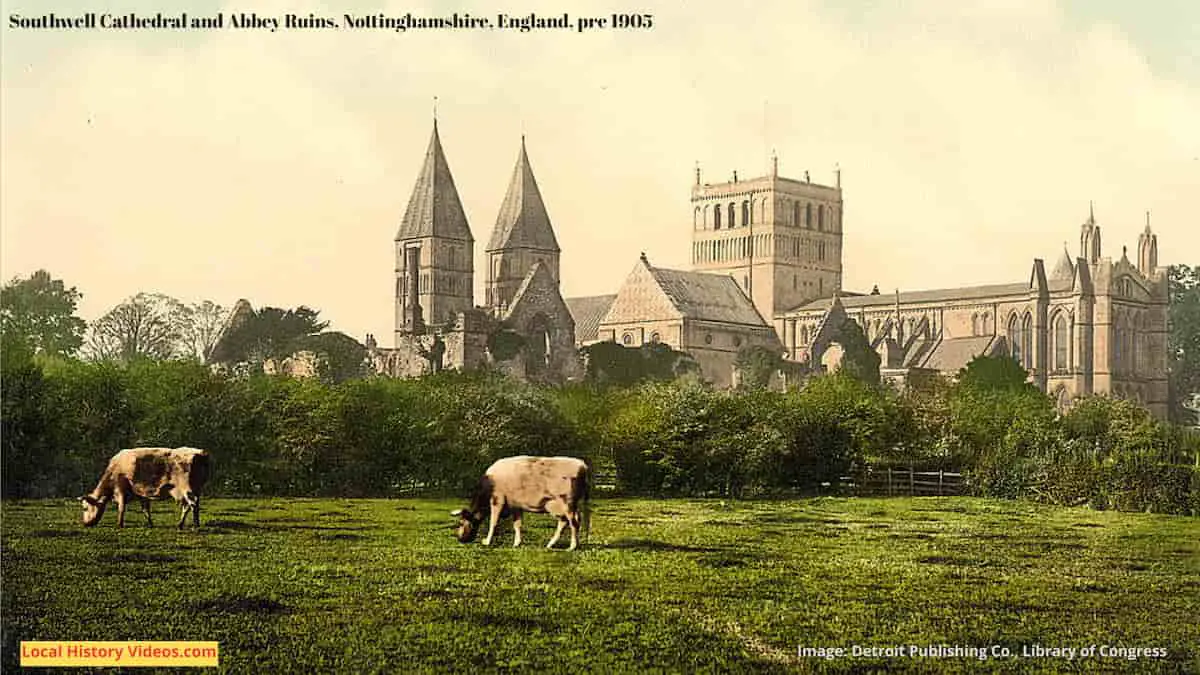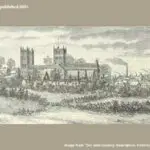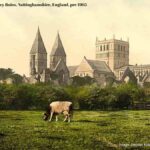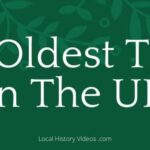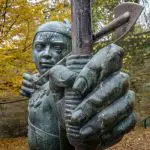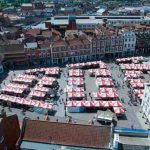Enjoy a glimpse of history through old images of Southwell, Nottinghamshire, England, UK.
Old Pictures of Southwell
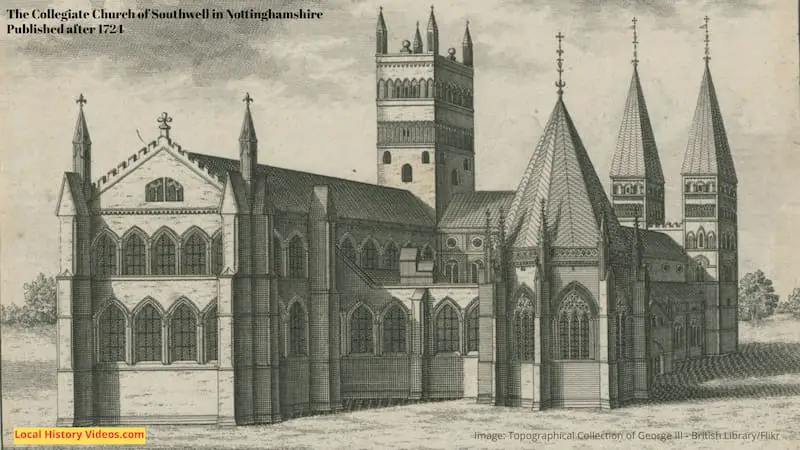

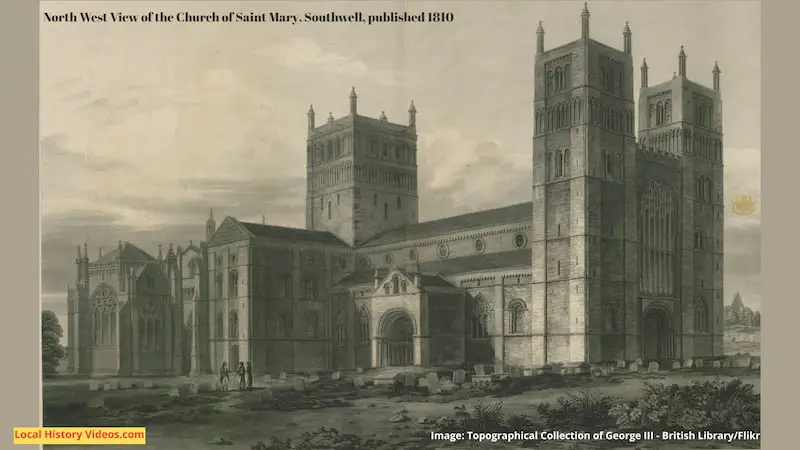
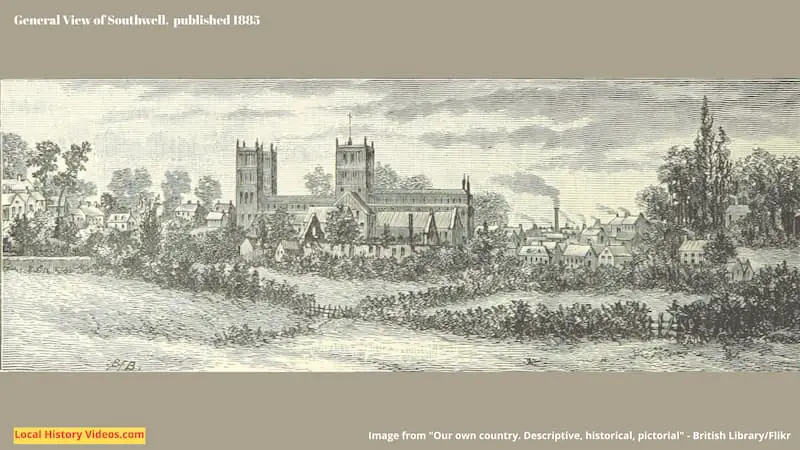

Old Photos of Southwell
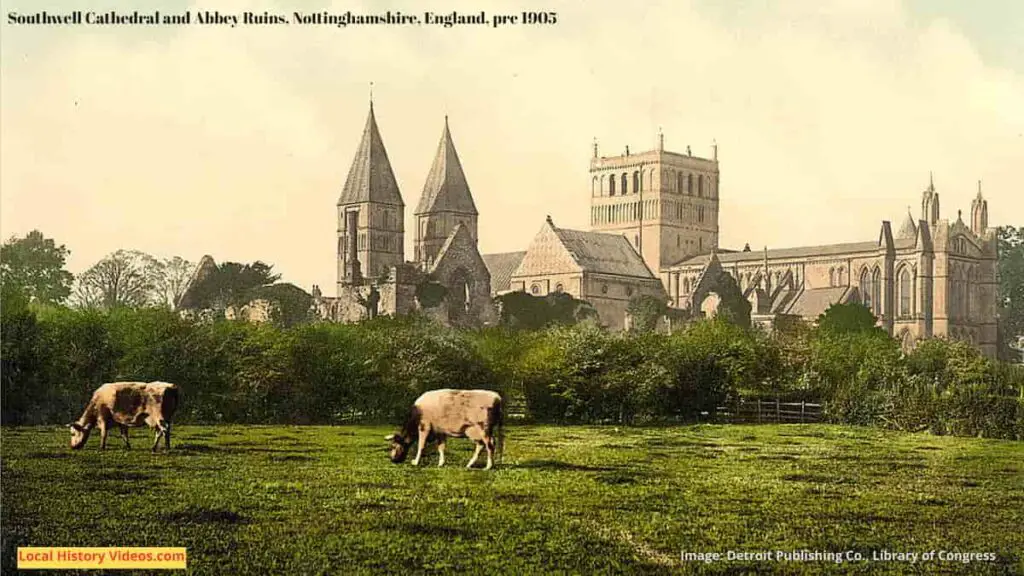
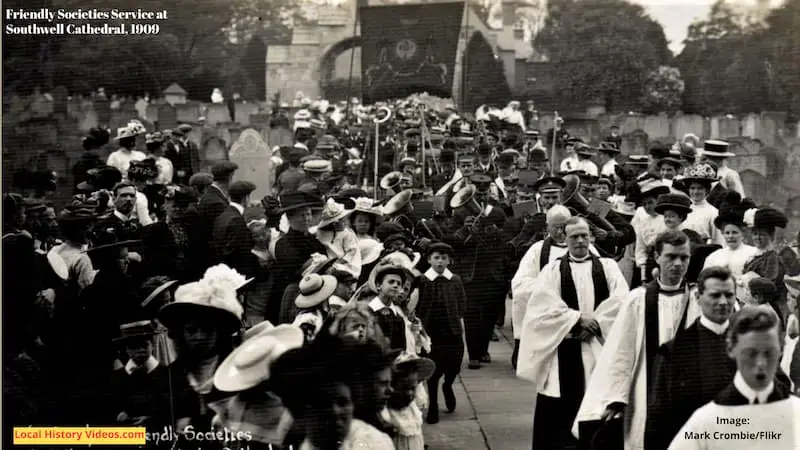
Old Map of Southwell
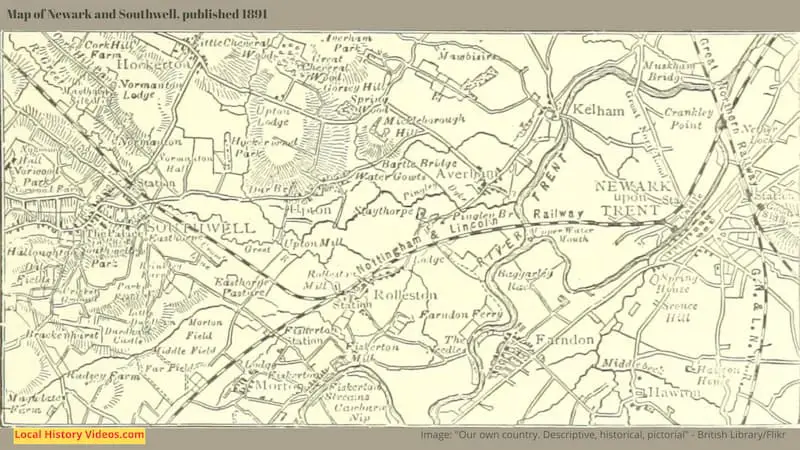
New Bishop (1928)
In 1928, the new Bishop of Southwell performed the ancient tradition of demanding admission to his Cathedral, where he was to be installed and enthroned.
Open Me The Gates Aka Open The Gates (1928) – British Pathé on YouTube
A Bit of Southwell History
Extract from:
“Post Office Directory of Derbyshire and Nottinghamshire“
Published in 1881
Pages 293 – 298
SOUTHWELL, anciently Suwelle and Sudwell, and at a still earlier period called Fings – Ceaster, is a market, union and polling town for the Southern division of the county, township, parish and station on the Mansfield, Southwell and Newark line of Midland railway, in the Newark county court district, in the rural deanery of Southwell, archdeaconry of Nottingham and diocese of Lincoln, delightfully situated on elevated ground near the western bank of the little river Greet, a tributary of the Trent, surrounded by fertile vales, encompassed by hills of considerable height and commanding an extensive view of the surrounding country.
Southwell consists of 5 parts, viz., HIGH Tows, or PREBENDAL, BASTHORPE and WESTHORPE on each side and BURGAGE and NORMANTON. The distance from London is 132 miles by road and 128 by railway, 7 west from Newark, 14 north – east from Nottingham and 22 from Lincoln.
Southwell had once four famous wells, reputed to possess healing powers of an almost miraculous character; two of these, situated near the church, are now filled in, or covered over; the springs of the others run as strongly as ever, but the wells have disappeared.
Petty sessions are held on Fridays, once a fortnight, at the Town Hall, which is a modern building, situated in West gate, where the market is held.
The collegiate churels of St. Mary was founded by Paulinus, first archbishop of York, about A.D. 630, and finally surrendered to Henry VIII. in 1540, but the king refounded the chapter in 1643, and endowed the church anew with the greater part of its ancient possessions, its revenue being then estimated at £ 516 18. 61d. although it suffered again during the reign of Edward VI. who dissolved the chapter and granted the prebendal and other estates to John, Earl of Warwick, afterwards Duke of Northumberland; the latter, on his execution, were restored by Queen Mary and a charter was subsequently granted by Queen Elizabeth and confirmed by James 1.: these details, successively re counted, are to be found under date of 1608, inscribed on a pillar in the nave, called Lee’s pillar, from Gervase Lee, the writer of the inscription: in the time of William 1. The ecclesiastical body consisted of ten prebends, six others being afterwards added: in the first year of Edward VI. it was stated to consist of sixteen prebends and as many vicars choral, the Archbishop of York being sole patron, while in royal and apostolic charters the same privileges were assigned to its members as to the canons of York: the revenue was then divided into five parts, respectively allotted ( 1 ) to residentiary canons, ( 2 ) prebendaries, ( 3 ) vicars choral, ( 4 ) chantry priests, ( 5 ) expenses connected with the fabric: the lands belonging to the church lay chiefly in Southwell and Normanton: since each prebend appointed and paid his own vicar choral, there were sixteen of these, whom Walter Grey, Archbishop of York in 1216, erected into a college and appointed them statutes; in 1307 they had residential buildings on the east side of Greet Brook, at a later period in the churchyard, and these premises were rebuilt in 1780; previous to this restoration the edifice was entrusted with oriel windows, porches and projecting oratories, three of which, still remaining, are de corated with the emblems of York and Lancaster and the name ” Wilhelmus Talbot: ” the chantry priests were thirteen in number, and had a large house at the north west corner of the churchyard, which was standing in 1787; many chantries were founded in this church at an early period, an account of which is given in the White Book of Southwell: there were also six choristers receiving a statatable annual salary of £ 2, afterwards increased to £ 3: the present collegiate establishment consists of a rector, one minor canon, an organist, six lay clerks and eight choristers, but by the Bishopries Bill of 1878 it is proposed, on the completion of the requisite endowment, to erect Southwell into an independent see; the sum still to be collected, according to the last printed report of the Southwell Bishopric Endowment Fund, was £ 30,000, but since its publication the old palace, with 44 acres of land, has heen purchased by the Bishop Suffragan of Nottingham, reducing the required amount to £ 4,000: the proposal to found a Bishopric here is not wholly new, since Southwell was one of the new sees projected by Henry VIII. and to which Richard Cox, afterwards Bishop of Ely, was appointed in 1543: the church itself is a large and magnificent cruciform structure, of Bolsover magnesian limestone, consisting of choir, save, transepts, chapter house on the south – east, north porch, central and two western towers, the central tower containing a fine peal of 8 bells, with a tenor weigh ing 33 ewt. successors of the two large bells recorded to have been given by Archbishop Alfrie, who held the see of York from 1023 to 1050; the second and fifth bells have been recast: the nave and transepts, as well as the towers,
are Norman; the choir, its aisles and small eastern transepts Early English; and the chapter house Early Decorated, all of very excellent composition, and there are some Perpendicular insertions; the nave consists of one small and seven large arches of two orders, with a label, supported on short but massive piers 9 feet high and 15 feet in diameter, the caps decorated with ribbed or cushion moulding: its aisles are vaulted in stone, most of the windows being later insertions: the triforium, like that of Blyth, is unusually large and has wide semi – circular arches with zig – zag mouldings on short piers, with dwarf columns at the angles: the clerestory windows are small, showing circles on the outside, surmounted by an original parapet of Mansfield stone; the elerestory is vaulted throughout, and within, the windows are enclosed by archies supported on two small shafts, similar to those of the trilerium; the roof of the nave, dating only from 1711, is flat and of panelled oak, finely carved: the western towers rise in five successive stages and are highly enriched in the upper three, the fifth or belfry storey exhibiting interlaced areading of Norman arches in the north – west and pointed arches in the south west tower, the latter having also a Decorated window in the aisle range; both have plain parapets and cylindrical pinnacles at the angles: until 1801 these towers were crowned with spires of wood, covered with lend, which appear to have been removed for the sake of the metal, but they have been recently reconstructed in the same manner, under the direction of Mr. Ewan Christian, from old illustrations, and an original drawing by Turner, executed shortly before their removal: the west front is lighted by a large Perpendicular window, still retaining some fragments of its original glazing, beneath a battlemented parapet, and has a fine Norman doorway of five orders; above the basement is a string course with chevron mouldings, which also runs entirely round the building: the transepts date from the period 1109-14; the fronts of each wing being of two bays with three tiers of windows, there having probably been an eastern apse in the south wing; between these, supported on four massive Norman arches, simple in style and stately in elevation, rises the central tower, with an open lantern of two stages, pierced with couplets of windows in each stage on every side, and terminating in a plain parapet with four principal and as many inferior pinnacles: the choir, begun about 1230, affords a perfect example of the Early English of Henry III. and Edward 1. and is one of the best illustrations of this style in the kingdom; it bears traces of having been erected on the site of an older structure, probably the early church of Paulinus, and consists of six bays opening into aisles, two airlekss bays beyond forming a Lady chapel; the piers, composed of clustered columns, support elegantly – shaped arches, enriched with dog – tooth ornament; the vaulting- shafts, banded midway, rise from corbels, and the triforium, arranged with two elegant openings in each bay, consisting of Barrow arches on triplets of columns, exhibiting all the enrichments peculiar to this style, is perhaps unrivalled for purity of design and fidelity of minute de tail: an elaborate stone screen, of Decorated work, dating from about 1350, encloses the choir westward, and consists of three open arches on elegant columns with foliaged ends, presenting some of the most beautiful among the known examples of this kind of ornament produced in the latter part of the fourteenth century; these arches have ogee tresoils of graceful design in the head, and triangular crocketed hood mouldings, terminating in a finial, and are flanked on either side by arched stone panels, similarly treated; the cornice being adorned with beads and other figures: the chapter
house is octagonal and is connected by a cloister with the north aisle of the choir; exteriorly, it has massive canopied and erocketed buttresses terminating in pinnacles, and a pointed roof, and is surrounded with a pierced parapet: the interior entrance from the cloister is through a doorway of extremely elegant and beautiful design, consisting of a recessed arch, supported on a series of columns, the caps of which are most exquisitely carved in imitation of leaves and flowers, both the archivolt and the spaces between the shafts being enriched with carved foliage; the doorway is divided into two by a single clustered shalt, forming open trefolled arches, the remaining space being filled with a quatrefoil; the roof is of stone, vaulted, but there is no central pier, the small diameter of the building not requiring it: the windows are of three lights, with geometrical tracery in the heads and the surrounding stalls, light and simple in design, are divided by single columns, surmounted by triangular floriated canopies: the eastern front of the minster is bisected by a pier as at Romsey and Pershore, and has two tiers of lancets, of which the four lower lights were glazed with einque – cento glass, by Gully Knight, in 1818: on the eastern side of the north – west transept is an Early English building, erected during the period 1248-00, and formerly a chantry or singing school, the lower part of which now constitutes the library, consisting of about 1,800 volumes of miscellaneous literature, with some few of value, the greater part being gilts from different prebendaries and canons of the church: the well known White Book of Southwell, ” an ancient register of the church, still pre served in the library, contains grants from the period of the Conquest to nearly the end of the reign of Henry VIII.: here also is kept the ancient register of Thurgarton Priory: the upper storey of the building is used as a treasury: the north porch, situated midway down the nave, is of magnificent proportions and deeply recessed: the choir retains five Decorated sedilia of late thirteenth century work, and stalls restored by Bernasconi; the organ was built by Father Schmidt, and renovated by Snetzler in 1766: a singular history attaches to the brass eagle lectern, a gift to the church from Sir R. Kaye, who purchased it of a watch maker in Nottingham, into whose hands it had fallen on the sale of the fifth Lord Byron’s effects in 1778: it originally belonged, it is said, to Newstead Abbey, and was fished up from the adjacent lake in the last century; subsequently it was sent to a brazier for repairs, who, on unscrewing the hollow pedestal, found therein a number of royal grants and other parchments relating to the abbey, from which it is inferred that the monks, on the dissolution of their house, had adopted this singular but successful method of preserving their records; the lectern bears the inscription, ” Orate pro anima Radulph Savage, et pro animabus omnium fidelium defunctorum: ” the church plate includes two chalices and patens, dated 1663: of the many archbishops of York, connected by residence with this church, six are known to have been buried within its precincts, viz. Geoffrey de Ludeham, in 1264; Thomas de Corbridge, 1303; William Booth, 1464; Lawrence Booth, his brother, 1480; Robert Holgate, about 1545 and Edwin Sandys in 1588: the tomb of Archbishop Sandys, formerly on the north side of the choir, is now in the north transept, and consists of a large altar tomb of alabaster with his recumbent effigy, the sides of the tomb bearing the figures of his children, together with a
long Latin inscription: an altar tomb, formerly on the north side of the choir, with a headless figure, and now in the south transept of the choir, has been conjectured to be that of Archbishop Ludeham, but is probably of later date; the brass of Archbishop de Corbridge has disappeared from its stone, now in the north transept, as well as others formerly upon a plain alter tomb on the south side, assigned to Archbishop Holgate; of the Booths, Archbishop William was interred beneath a stone in the south aisle, where also was once the altar tomb of Archbishop Lawrence Booth: in the chapter house is an inscribed stone to William Talbot 1485: the dimensions of the church are – total internal length 313 feet, length of transept 126 feet, of nave 143 feet 7 inches by 66 feet broad; the central tower is 116 feet in height, and its base 40 feet square; and the western towers have a wall – thickness of 4 feet 6 inches: the whole edifice is now undergoing thorough repair, including as already described, the reconstruction of the western spires, the re – roofing of the nave, aisles, transepts, library and chapter – house,
the renewal of the flooring generally, and the refitting of the choir with new stalls; the accumulated cost being estimated at about £ 20,000; a sum of £ 4,000 was expended on repairs in the last century, in consequence of a violent storm on the 11th November 1711, when the southern spire was fired by lightning, part of the roof and central tower burnt, the bells melted and the organ destroyed. There were anciently five chapels in this parish: one in Palmer’s yard, Easthorpe: a second about half a mile from this; a third in the hamlet of Normanton, used in 1787 as a barn; a fourth, St. Catherine’s chapel, stood at the extreme end of Westhorpe, and gave its name to the neighbouring well; the fifth was at the upper end of Farthing Street; none of these chapels are now standing, the last, at Normanton, laving been pulled down about 40 years since. About 1780
spacious stone building was removed from the corner of the hill close abutting on Burgage Hill, supposed to have been part of the hospital of St. Mary Magdalen, existing here in 1313. Three gateways to the minster precincts, and some remains of a fourth, were standing in 1787, two being on the north side of the church, and two on the west; of these, one now remains on the west, another on the north – east, and a third on the north. The ancient palace of the archbishops of York, now in a partially ruinous condition, is situated about 30 yards south of the minster, and immediately adjoining the churchyard: it was begun by John Kempe, archbishop from 1425 to 1452, and completed by his successor, Archbishop William Booth and other subsequent prelates, and was a favourite residence of Cardinal Wolsey: the buildings, when perfect, formed a large quadrangle, with gardens and park immediately adjacent on the south: there are considerable remains of the south, eastern and north elevations all in ruins, except the grand old banqueting hall of Henry VI.’s time, on the north, over a subordinate storey below; there remain also on this side the eastern gable and portions of the walls of the chapel; between these, at the ends of the northern elevation, is an open space, which will probably be filled up by the proposed new buildings, and will thus connect the chapel and hall together; westward of the hall is a modern addition, forming a dwelling – house; these remains are remarkably picturesque, and the whole palace could, if
necessary, be fully rebuilt, but it is considered probable that one side of it will amply suffice for the needs of the future bishops of Southwell: the Bishop of Nottingham has, with great liberality and public spirit, purchased the existing structure, together with all the old archiepiscopal gardens and a small portion of the park, and is shortly about to
restore to its original stateliness the ancient banqueting hall, replacing in its windows the royal and other shields of arms which once adorned them, as well as afterwards the chapel, intending to dedicate the restored palace to the use of the refounded see. The register dates from the year 1559, and is in good condition. The living is a rectory, yearly value £ 450, with residence, in the gift of the Bishop of Lincoln and held by the Rev. James John Trebeck B.A. of Christ Church, Oxford; Hev. Robert Frederick Smith M.A.
of Lincoln College, is the minor canon.
At the time when Southwell palace was the residence of the archbishops of York, and its magnificence and hospitality at their zenith, the prelates had four parks in its vicinity, viz. Southwell, or the Little Park, on the confines of which the palace stood; Hockerwood, about a mile north east; Hexgrave, about 4 miles north – west; and Norwood, half a mile west. Hexgrave, in the parish of Farnsfield, contains the remains of an ancient encampment of considerable extent, and is the seat of G. Sugden esq.; the mansion is pleasantly situated in about 800 acres of land. Norwood, a mile north – west, extends over 90 acres, and is now the property of J. E. Chambers esq.: in the park is still standing the oak known as ” Cludd’s Oak, ” after Mr. Edward Cludd, a famous Parliamentarian justice during the period of the Civil War, who having purchased the estate and built a house thereon, was wont to solemnize marriages, according to
the custom of those days, beneath the boughs of this venerable tree: he died bere in 1672 and was buried in the nave of Southwell church. The Hall, a handsome red brick mansion, is of modern date, and pleasantly situated, nearly in the centre of the park. The Residence House, a modern building, together with the houses of the vicars – choral, forms a quadrangular block of buildings, situated eastward of the church.
Holy Trinity is an ecclesiastical parish, formed in 1846: the church, built by subscription for the district of Westhorpe, was consecrated 31st March, 1846, and erected at a cost of about £ 4,000, £ 1,000 being given for the endowment: it consists of chancel, nave of five bays, aisles, porch and a western tower with a lofty spire, containing 1 bell: the
extreme length from east to west is 122 feet; height of spire from the pavement to the top of vane, 150 feet: a parsonage house was built by subscription in 1860. The register dates from the year 1846. The living is a vicarage, yearly value £ 230 net, partly arising from the pew rents and partly from grant from the Ecclesiastical Commissioners, with one acre of glebe, in the gift of trustees and held by the Rev. Arthur Charles Garbett M.A. of Hertford College, Oxford.
The Wesleyans have a chapel, built in 1840, in Prebend yard, and the Baptists a large and commodious building in Moor lane.
The Grammar school has now an annual endowment of about £ 22, paid to the master, who has also a free residence adjoining the Minster yard; that portion of it formerly contributed by the Chapter and the Prebend of Normanton being now paid by the Ecclesiastical Commissioners, while the £ 10 granted yearly at Midsummer by Edward VI. from the Exchequer, is represented by a sum of £ 7 13s. 5d. derived from the Woods and Forests: ” there are no free boys, strictly speaking, but the choristers from the Minster are educated at reduced fees, paid by the Ecclesiastical Commissioners; they formerly enjoyed the exclusive advantage of two scholarships and two fellowships attached to St. John’s College, Cambridge, founded in 1531 by Dr. Keton, canon of Sarum, for ” scholars, choristers of Southwell; ” these rewards were eventually dissociated from the school and thrown open to general competition, the last legitimate
holder being the present archdeacon of Nottingham: the scheme of instruction includes such branches of literature and science as are usually held necessary for a liberal education, while it provides, at the same time, a thoroughly sound training for boys intended afterwards for commercial life: the ordinary tuition fees amount to £ 4s. 48. per annum, and in the higher course to £ 12 12s: boarders are received from 17 to 23 guineas per annum. Visitor, The Right Rev. the Lord Bishop of Lincoln; head master, Mr. John Wright; second master, Mr. J. S. Wright B.A. late scholar of Corpus Christi college, Cambridge.
There are several charities, amounting to about £ 75 yearly, left for the relief of the poor and the education of poor children.
There is a Savings Bank, established in 1818.
Malting is carried on here, and there is a silk factory, employing about 100 hands. Bricks are also made and a few knitting frames are worked.
The Manor House, now inhabited by Miss Monckton, in the Burgage part of the town, was formerly the residence of Lord Byron, the poet, who spent many of his boyish days here.
Normanton Hall, the seat of Thomas Francis Rolt esq. is a handsome mansion, situated in 30 acres of land, on an acclivity about a quarter of a mile from Southwell station, overlooking the town and commanding a fine view of the surrounding country.
Southwell has not been without royal visits: King James I. passed through the town in 1603, when on his way to London to assume the crown of Great Britain; and at the beginning of the civil war, Charles I. immediately before raising the royal standard at Nottingham, came to Southwell on the 18th August, 1642, and again, after the fatal engagement at Naseby, 14th June, 1645; finally, it was on the 6th of May, 1646, that the hapless monarch once more arrived at Southwell, and taking up his quarters at the King’s Arms, surrendered himself to the Scots ‘ Commissioners, who were sitting in the Archbishop’s palace.
The Ecclesiastical Commissioners are lords of the manor.
The acreage is 5,645; rateable value, £ 17,384; the population in 1881 was 2,866.
Parish Clerk, Peter Coxon.
Official Establishments, Local Institutions & c.
POST, MONEY ORDER & TELEGRAPH OFFICE,
Savings Bank & Government Insurance & Annuity
Office & Stamp Office.
Postmaster – Richard Swift, King street.
Letters arrive at 4.45 a.m. & at 3 p.m.; delivered at 7 a.m.;
dispatched at 8 p.m. Box closes at 7.45 p.m. but letters
are received until 7.55 by payment of an extra id. stamp.
Money orders are granted & paid between the hours of
9 a.m. & 6 p.m
RECEIVING OPPICE, Westhorpe, William Hall, receiver.
There are WALL LETTER BOXES in Easthorpe &
West gate
Daily Posts. To Westhorpe, Halam, Edingley & Farns
field, Henry Bradbury, postman; to Halloughton, Thur
garton & Bleasby, John Ulyatt, postman; to Oxton,
George Hewitt, postman; to Upton, Hockerton, Wink
burn & Kirklington, Jesse Whiles, postman; leaving
Southwell at 6.30 a.m. & returning at 7 p.m
COUNTY MAGISTRATES FOR SOUTHWELL DIVISION.
John Henry Becher esq. Southwell
J. E. F. Chambers esq. Norwood park
Rev. Thomas Coats Cane, Southwell
Robert Kelham esq. Bleasby hall
Col. B. S. Pegge – Burneil, Winkburn ball
Charles Storer esq. Lowdham grange
Colonel William E. Warrand, Westhorpe hall
Clerk, George Kirkland, Church street
Petty Sessions held on alternate fridays in Town hall.
Places in the Petty Sessional division are: -Bleasby,
Bilsthorpe, Eakring, Edingley, Farnsfield, Fiskerton,
Halam, Halloughton, Hockerton, Hoveringham, Kirk
lington, Morton, Southwell, Thurgarton, Upton & Wink
burn
INSURANCE AGENTS.
British Empire Mutual Life, W. Booth, Easthorpe
County Fire, Henry E. Greatorex, Smith’s bank
Imperial Fire, G. S. Brameld, Market place
Law Life, H. C. Stenton, Market place
Law Union Fire & Life, George Kirkland, Church street
North British & Mercantile, J. H. Bradwell, Burgage
Provident Life, H. E. Greatorex, Smith’s bank
Royal, J. Wright, Charch street
Scottish Equitable Life, J. Whittingham, Queen street
West of England, T. Bates, Queen street
Yorkshire Fire & Life, A. T. Metcalfe, Market place
PUBLIC ESTABLISHMENTS.
Inland Revenue Office, Saracen’s Head, ” Market place
Police Station, Burgage, William Webster, inspector & one
constable; with one at Farnsfield, one at Eakring & one
at Fiskerton, being a subdivision to Newark
Savings Bank ( established March 31st, 1818 ), John Kirk
land, actuary & secretary
Stamp Office, Richard Swift, distributor
SOUTHWELL UNION.
Board day, tuesday, fortnightly.
The Union comprises the following places: -Averham, Bathley, Bilsthorpe, Bleasby, Boughton, Budby, Buleote, Carlton – upon – Trent, Caunton, Caythorpe, Clipstone, Cromwell, Eakring, East Stoke ( part of ). Edingley, Edwinstowe, Egmanton, Elston, Elston Chapelry, Epperstone, Farsfield, Fiskerton, Gonalston, Grassthorpe, Gunthorpe, Halam, Halloughton, Hockerton, Holme, Hoveringham, Kelham, Kersall, Kirklington, Kirton or Kirkton, Kneesall, Laxton or Lexington, Lowdham, Maplebeck, Morton, North Muskham, Norwell, Norwell Woodhouse, Ollerton, Ompton, Ossington, Oxton, Park Leys, Perlethorpe, Rolleston, Rufford, South Muskham, Southwell, Stay thorpe, Sutton – upon – Trent, Syerston, Thorpe, Thurgarton, Upton, Walesby Wellow, Weston, Winkburn; the rateable value is £ 207,569.
Clerk to Guardians, John Kirkland, Church street
Assistant Overseers, Epperstone, Samuel Willis; Farns
field, Thomas Tongue; Fiskerton, James Long; Kelham,
Eli Crampton; Lowdham, Thomas Haslam; Morton,
James Long; Oxton, William Wain; Southwell, Thomas
Holt; East Stoke, Thomas Moore; North Musk ham,
George Jackson; Sutton – on – Trent, Joseph Day; Weston,
William Sandifer
Collectors & Relieving Officers, Arthur Blundell, No. 1
district; Jason Adamson, Kneesall, No. 2 district
Medical Officers & Public Vaccinators, C. Calvert, West
gate, Southwell, Southwell district; H. P. Long, South
well, Farnsfield district; R. H. Sers, Epperstone,
Lowdham district; J. F. Greenwood, Newark, Caunton
district; F. H. Appleby, Newark, Sutton – on – Trent dis
trict; C. H. Whitington, Tuxford, Loxton district;
E. Wright, Ollerton, Ollerton district
Superintendent Registrar, John Kirkland, Church street
Registrar of Marriages, George Kirkland, Church street
Registrars of Births & Deaths, Arthur Ble
Easthorpe, South district; & Jason Adamson, North
district
The Union Workhouse is situated on a pleasant spot in the parish of Upton, a short distance from the town of Southwell, & near the railway: it was erected is 1824, at a cost of £ 6,506, for 49 parishes, associated under Gilbert’s Act, & will hold 191 inmates: the building is large, & well arranged, with about six acres of ground, principally laid out as a garden: the infirmary was added in 1870, at a cost of £ 1,000. William Shackloek, master; Rev. Richard B. Earle, chaplain; Campion Calvert, surgeon; Mrs. Mary Ann Shacklock, matron
RURAL SANITARY AUTHORITY.
Clerk, John Kirkland
Medical Officer, Charles Wills, Mansfield
Inspector of Nuisances, Henry Dixon, Southwell
Fire Engine House, Queen street. Keys kept at William
Butler’s, Queen street. There are twelve firemen appointed, residing in different parts of the town, numbered from 1 to 12, & distinguished by a strip of hoard placed over their doors, with the word ” fireman ” & the number written on it
Gas Co. Easthorpe, John Kirkland, secretary
Southwell District Highway Board, John Kirkland,
Church street, clerk; John Garratt, Oxton, surveyor
Town Hall, Westgate
PUBLIC OFFICERS.
Assessors & Collectors of Taxes, Jabez Adamson & Thomas
Watts, Westhorpe
Clerk to the Commissioners of Tazes, John Kirkland,
Church street
Inland Revenue Officer, Francis Houston, Westgate
Steward to the Copyhold Courts, Southwell, Wood
borough, Laneham, Scrooby, Ranskill, Sutton – cum
Lound & Askham, Henry Cawdron Stenton, Market pl
Surveyor of Taxes, H. P. Pacey
Town Crier, Henry Swift, Queen street
PLACES OF WORSHIP.
SOUTHWELL COLLEGIATE CHURCH.
Minor Canon, Rev. Robert Frederick Smith M.A
Rector, Rev. James John Trebeck B.A
Organist, Arthur Marriott
Verger, Peter Coxon
Trinity Church, Rev. Arthur Charles Garbett M.A. vicar
Baptist Chapel, Rev. J. H. Plumbridge, minister
Wesleyan Chapel, Rev. William Calvert, minister
SCHOOLS.
Grammar, John Wright, master; J. S. Wright H.A. second master
National, Moor lane, erected, with a residence for the master & mistress, in 1840, will hold 200 children; Henry Salt, master
Endowed Free, Easthorpe, endowed with £ 35 per annum, left in 1780, the children paying a small weekly fee; Mrs. Linney, mistress
Infant, West gate, built in 1860, & available for about 220 children; Miss Elizabeth Dixon, mistress
Wesleyan, Queen street, William George, master
CONVEYANCE.
Railway Station, George Peck, station master
Omnibus to meet all trains
CARRIERS.
NEWARK – Wm. Gibson & Thomas Fryer, mon. wed. & fri
NOTTINGHAM – Thomas Fryer, tues. thurs. & sat
PRIVATE RESIDENTS.
Barlow Thomas, Church street
Barnett Henry Conway, Station rond
Becher John Henry J.P. Hill house
Becher Mrs. Hill house
Berry Mrs. Easthorpe
Biddle Richard, Capri villa, Westhorpe
Bradley John Northage, Westhorpe
Brameld Gudfrey Sherwood, Church st
Brookes John, Station road
Brown Cornelius. Alma bo. Westhorpe
Burton Mrs. Park street
Calvert Campion, West gate
Calvert Rev. William Wesleyan ],
Park street
Cane Rev. Thomas Coats J.P. [ vicar of
Kirklington ], Brackenhurst
Caudwell Charles
Chambers John E. F. J.P. Norwood pk
Chouler Mrs. Burgage
Clay Miss, Easthorpe
Clay Mrs. Burgage
Clayton Edward, West gate
Clements Thomas, West gate
Dixon Mrs. Park View house
Drummond Hay Sir Edward Hay, –
South hill
Earle Rev. Richard Bethel [ vicar of
Edingley & chaplain of Southwell
Union ], Church street
Elliot George Stokoe M.D. Spring ter
race, Easthorpe
Elsam Thomas, Norwood villa
Fitzjoln Rev. Thomas Lechmere Tudor
M.A. [ curate ]
Fryer Samuel, West gate
Garbett Rev. Arthur Charles M.A.
Holy Trinity vicarage, Westhorpe
Gee Mrs. Park house
Glaister Mrs. Burgage
Gordon Mrs. West gate
Greatorex Henry Edmund
Hall Mrs. Easthorpe
Heathcote Mrs. Burgage bill
Hodgkinson Miss, West gate
Hutchinson Mre. The Palace
Jackson Mrs. Easthorpe
Johnson James, Maythorne
Kirkland John, Church street
Kirkland George, Church street
Kirkland John William, Church street
Langtry George, Park gate
Leek Mrs. Park street
Long Henry Plater, Westhorpe lodge
Machin Henry, Easthorpe
Machin John, King street
Marriott Mrs. Westgate
Meugens Peter Joseph, Westhorpe
Metcalfe Arthur Tom F.o.s. Market pl
Monekton Miss, Manor house
Naylor Mrs. Market place
Neepe Miss, Burgage
Osborne John Henry, Church street
Parkinson Leonard, West gate
Pigot Mrs. Easthorpe
Plumbridge Rev.J.H. Baptist ], Park st
Rawson Mrs. Station road
Rolt Thomas Francis, Normanton ball
Smith Rev. Robert Frederick M.A.
( vicar of Halam ], Vicar’s court
Stenton Henry Caudron, West gate
Stenton Richard Henry, West gate
Sutton Miss, Church street
Sutton Rev.Arthur Frederick [ curate ),
Easthorpe
Swift William, West gate
Tatham Mrs. Vicar’s court
Taylor Miss, King street
Trebeck Rev.James John B.A. [ rector ],
Easthorpe
Walker Thomas, Hardwick house
Warrand Col. Wm.E.R.E., J.P.Westhrpe
Warrand Mrs. Westhorpe
Warwick Mrs. West gate
Warwick Richard Huskinson
Watkins Mrs. Vicar’s court
Wintour Mrs. West gate
Woods Mrs. Easthorpe
Wright John, Church street
Young William M.R.C.v.s. West gate
COMMERCIAL.
Adams George, naturalist, King street
provision Adamson Jabez, grocer &
dealer, assessor & collector of taxes
& see. to Wesleyan Friendly Society
Adamson Sarah ( Mrs. ), stay ma. West gt
Allobrook Samuel, Lord Nelson,
West gate
Bacon Thomas, grocer, baker, confec
tioner & provision merchant, King st
Barker Charles, farmer, Westhorpe
Barker William, shopkeeper, West gate
Barlow Elizabeth ( Mrs. ), grazier, Radley
Bates Thomas & Co. family grocers,
agents for the Cromwell Brewery Co.
Newark ales & stout, Guinness’s double
stout, & Bass’s ale in cask & bottle,
Findlater & Co. Dublin stout in casks
& agent for W. & A. Gilbey, wine &
spirit merchants, Queen street
Bee David, printer & c. Westgate
Blancher Thomas, saddler, King street
Blundell Arthur, registrar of births &
deaths, Easthorpe
Bond Charles, general dealer, Easthorpe
Bradwell John Howard, land surveyor
& estate agent, Burgate; & Commer
cial buildings, Long row, Nottingham;
& Swan hotel, Mansfield
Brameld Godfrey Sherwood, manager
of the Nottingham & Nottingham
shire Bank, Market place
Brown William, butcher & licensed
dealer in game, King street
Buckland Alfred, sewing machine agent,
jeweller & boot & shoe factor, Market pl
Buckland Wm.boot & shoe ma. Easthorpe
Budd Wm. market gardener, Easthorpe
Burdin & Price, wheelwrights, Westgate
Burdin Williarn, farmer, Easthorpe
Butler Edward, plumber, Kirklington rd
Butler William, blacksmith, Queen st
Calvert Campion, surgeon, West gate
Caudwell Edward, miller, Water mills
Caudwell Lydia ( Mrs. ), coal dlr. King st
Chadburn Arthur, draper & grocer,
wine & spirit merchant, Allsopp’s pale
& burton ales in cask & bottle, Lon
don & Dublin stout, agent for Messrs.
Moet & Chandon, Epernay; Manches
ter house, Market place & Queen st
Challand William, farmer, Brinkley
Chantry Samuel, higgler, West gate
Chappell Mary ( Mrs. ), btchr. Easthorpe
Childs William, watch ma. Queen st
Chilton George, farmer, Durdham
Clark William, farmer, Wheldon farm
Cottam Andrew, grocer, Easthorpe
Cottam George, dairyman, Easthorpe
Crawford Ann ( Mrs. ), farmer, Queen st
Croom Robt. chimney swpr. Easthorpe
Cropper Dorothy ( Miss ), dress maker,
West gate
Crosby Reuben, hair dresser, perfumer
& agent for the United Kingdom &
Imperial Union Insurances, King st
Davis Thos. Hy. saddler, Market place
Denman Frederick, brazier, West gate
Dixon Henry, Black Bull, & inspector
of nuisances to the rural sanitary
authority, King street
Dodd Mary Ann & Son, painters, King st
Dodd James, Ironmonger & grocer,
King street
Dominick Daniel, shopkeeper, Easthorpe
Donson William, shopkeeper, West st
Downing James Hy. chemist, King st
Drury George, chemist, Market place
Duckmanton Wm. farmer, Westhorpe
Elliott George Stoker M.D. surgeon,
Spring terrace, Easthorpe
Ellis George, brewer’s traveller, King st
Ellis George, shoe maker, Burgage
Ellis Robert, plumber, Queen street
Fines Sarah ( Mrs. ), milliner, Queen st
Fletcher Wm.Allen, provsn. dlr. Westgt
Foster Edward, blacksmith, Easthorpe
Foster Jas. wheelwright, Kirklington rd
Foster Thomas, blacksmith & cowkeeper,
Westhorpe
Foster William, shopkeeper, King st
Foster William James, baker, King st
Fryer Thomas, carrier, West gate
Gas Co. ( John Kirkland, sec. ), Easthorpe
Gibson Geo.machine owner, Normanton
Gibson Richard, grazier, Easthorpe
Gibson William, carrier, West gate
Glastone George, shoe ma. Easthorpe
Gleadle Geo, beer retir. Kirklington rd
Grammar School ( John Wright,
master; J. S. Wright B.A. 2nd mast )
Gregory John, stone mason, West gate
Grundy Charles, jeweller, draper, gen
eral outfitter & boot & shoe dealer,
Queen street
Grundy Richard, tailor, Westhorpe
Gyngell Lionel, ale & porter mer.We.gte
Hall Francis, Newcastle Arms
Hall George, shoe maker, Westhorpe
Hall Richard, shoe maker, West gate
Hallam John, gardener, Norwood hill
Harrison William, watch ma. Easthorpe
Harvey Richard, butcher, Easthorpe
Hatfield Richard, butcher & licensed
dealer in game, Church street
Heathcote Catherine ( Mrs. ), ladies ‘
boarding school, Burgage
Henderson James, farmer, Normanton
Hoe Richard, shoe maker, West gate
Holmes John, grocer, King street
Holmes John, shoe ma. Kirklington rd
Horsley John, draper, Queen street
Horsley Rachael ( Mrs. ), milliner, dress
maker, & wool & general fancy re
pository, King street
Horsley Robert, Saracen’s Head family
& commercial hotel & posting house;
omnibus to meet all the trains, Mar
ket place
Horsley Sl. Portland Arms, King st
Houghton Francis, farmer & grazier,
Westhorpe
Houghton
officer, West gate
Isherwood Frederick, Admiral Rodney
inn & commercial hotel, King st
Jallings Henry, butcher, Queen street
Jolinson Bean, farmer, Normanton
Johnson & Co. silk throwsters & lace
thread manufacturers, Maythorn mill
Keetley Henry, shoe maker, Easthorpe
Keetley Joseph, shopkeeper, Easthorpe
Kemp George, shopkeeper, West gate
Kirkland George, registrar of marriages
for Southwell union & clerk to the
magistrates, Church street
Kirkland John, clerk to the commis
sioners of taxes & highway board &
guardians, & superintendent registrar,
Church street
Kirkland Jn. Wm. sclicitor, Church st
Knowles Francis, house decorator &
ornamental painter, carver, gilder &
picture frame manufacturer;
paintings cleaned relined & restored,
Market place
oll
Lee Edward, plumber, West gate
Leek Brothers, coal, coke, lime, salt,
cake & corn merchants, Railway
station; agents for Ind, Coope & Co.;
brewers, Burton – upon – Trent, & the
Carrington Brewery Co. near Not
tingham; greengrocers & graziers;
attendance at Newark, wednesdays;
West gate & Queen street
Literary Society & News Room ( Rev.
James Barrow M.A. president; A. T.
Metcalfe P.G.S. vice – president; Alfd.
Buckland, hon, sec.; F. Knowles,
treasurer ), Market place
Linney William, farmer, Brinkley
Long Hy.Plater, surgn. Westhorpe Idg
Loughton Mary ( Mrs. ), whitesmith,
Queen street
Maltby Jas. Holland joiner & e. Easthorpe
Maltby Mary ( Miss ), dress ma. Moore la
Maltby Wm. Singleton, tailor, West gt
Marriott Arthur, organist of Southwell
Collegiate church & professor of
music. Vicars court
Mason Harriett & Elizabeth ( Misses ),
day school, West gate
Mason Thomas, painter, Easthorpe
Massey Philip, farmer, Westhorpe
May Harriett ( Mrs. ), shopkpr. West gate
Merryweather Henry, nurseryman,
The Nursery
Merryweather William, wheelwright,
Easthorpe
Metcalfe Arthur Tom P.G.S. solicitor &
commissioner for oatlis ( firm, Stenton,
Son & Metcalfe ), Market place
Miller John Robert, painter, West gate
Minkley John William, general &
furnishing ironmonger & agricultural
implement agent, West gate
Moore Samuel, Swan commercial inn;
horses & traps on hire, King street
Mountney Geo. cowkeeper, Easthorpe
NallGeo.Johnston, altster, King street
Newton Nathaniel, Wheatsheaf, King st
Newton William, solicitor, Market pl
Noble Richard & George, builders & con
tractors & brick makers, Church st
Nottinghams Nottinghamshire Bank
ing Co. ( Godfrey Sherwood Brameld,
man. ), Market pl.; draw on London
& Westminster Bank, London e.c
Oliver Edwin, tailor, Westhorpe
Ordidge John, grocer, draper & shoe
warehouse, West gate
Osborne John Hy. surgeon, Church st
Parker George, builder, Westhorpe
Plowman Joseph, farmer, Brinkley
Pyzer Samuel, news agent, King st
Pyzer William, tailor, West gate
Revill Mary ( Mrs. ), Hearty Good
Fellow, Basthorpe
Richardson Job, Shoulder of Mutton,
West gate
Richardson Wm. dairyman, Westhorpe
Richmond Thomas, beer retailer, shop
keeper & basket maker, Westhorpe
Rickett George, builder, Easthorpe
Rodman William, tanner & currier,
Westgate
Rogers Ann ( Mrs. ), shopkpr. Easthorpe
Rolfe Caroline Marin ( Miss ), ladies ‘
boarding school, West gate
Rollin William, farmer, Normanton
Rumford Jane ( Mrs. ), tea dealer, con
fectioner & dealer in british wines;
bride cakes in every design made to
order, King street
Rumford John, farmer, Normanton
Sandaver Samuel, gardener, King st
Sandaver Samuel, jan. china & glass
dealer, King street
Savings Bank ( John Kirkland, actuary
& secretary )
Saxby William, farmer, New Radley
Sharman John, Reindeer, West gate
Sharp Henry, Crown commercial &
family hotel & posting house; om
nibus to meet all the trains on receipt
of order, Market place
Simpson Edward, fancy repository & c.
King street
Shumach Henry, naturalist
Smedley William, shoe ma. Westhorpe
Smedley William, White Lion, Easthrpe
Smith & Nephew, brewers; & at Work
sop & Retford
Smith Samuel & Co, bankers, Market
place; draw on Smith, Payne &
Smiths ‘, London e.c
Smith Thomas, shopkeeper, Westhorpe
Southwell Brewery Co. Limited ( Geo.
Langtry, man. ), brewers & spirit mers
Southwell Co – operative Stores ( David
Bee, manager ), Westhorpe
Squires William Fredk. family grocer
& tea dealer, provision merchant & c.
Market place
Stafford John, cowkeeper, Westhorpe
Stanley Robt. Swan, chemist, Markt. pl
Stenton, Son & Metcalfe, solicitors,
Market place
Stenton Henry Candron, solicitor &
perpetual commissioner ( firm, Sten
ton, Son & Metcalfe ), Market place
Stenton Richard Heury, solicitor ( firm,
Stenton, Son & Metcalfe ), Market pl
Stout Francis, George & Dragon, & saddler, Easthorpe
Swift Henry, town crier, bailiff, bill poster & boot & shoe makr. Queen st
Swift James, shoe maker, King street
Swift Richard, stationer & postmaster, King street
Swift Samuel, butcher, King street
Taylor George, plumber, King street
Taylor William, livery & bait stables, omnibus & cab proprietor, horses & traps on hire
Taylor John, grazier, Easthorpe
Taylor Sarah ( Mrs. ), stay ma. King st
Taylor William, maltster, Burgage
Templeman George, baker, West gate
Tinley Edward John, seedsinan, corn factor & dealer in cake, King street
Tinley George, farmer, Old Radley
Town Hall Assembly Room ( Francis Knowles, secretary )
Townrow John, tailor & woollen draper, liveries, ladies ‘ riding habits & c. Market place
Wand Henry, butcher, West gate
Waterhouse Jeremh. grazier, Easthorpe
Watkin Henry, shopkeeper, Easthorpe
Watts Mary ( Mrs. ), grocer, King at
Watts Thomas, tailor, & assessor & collector & of taxes, Westhorpe
Wells William, farmer, Norwood farm
White Thomas, shoe maker, Westhorpe
Whittingham John, bookseller, stationer, printer, bookbinder & photographer, Queen street
Wild Thomas, painter, West gate
Wilkinson Philip, whitesmith, bell
hanger, gas, hot & cold water fitter & ironmonger, King street
Wilkinson Valentine, rope & twinemaker, Queen street
Willerton Richard, practical watch & clock maker, jeweller, silversmith & optician, King street
Wood Jas. Cowzin, farmer, Normanton
Woodward Thos.blacksmith, Westhorpe
Woodward Thomas Brittle, maltster, Easthorpe
Workman’s Rest Coffee & Reading Rooms (Thomas Daybell, manager), Westhorpe
Wright James, draper, King street
Wright Martha ( Mrs. ), ladies ‘ day school, King street
Wright Thos. boot & shoe ma.Market pl
Wykes John, shoe maker, King street
Young William M.R.C.V.S. veterinary surgeon, West gate
More about Nottinghamshire
- Old Images of Nottinghamshire, EnglandGlimpse history through old images of Nottinghamshire, England, UK.
- Old Images of Southwell, NottinghamshireEnjoy a glimpse of history through old images of Southwell, Nottinghamshire, England, UK. Old Pictures of Southwell Old Photos of Southwell Old Map of Southwell New Bishop (1928) In 1928, the new Bishop of Southwell performed the ancient tradition of demanding admission to his Cathedral, where he was to be installed and enthroned. Open Me… Read more: Old Images of Southwell, Nottinghamshire
- Donald Birkinshaw, Photographer (1922-1988)Donald Birkinshaw was a British photographer (1922-1988) who took a particular interest in rural landscapes and country settings.
- The Majesty Of Major Oak In Sherwood ForestMajor Oak is a thousand year old tree found in the Sherwood Forest in Nottinghamshire. It’s so big, vertical poles stop the heavy branches collapsing.
- Nottingham: Old Photos & FilmThe city of Nottingham, found in the East Midlands region of England, has a central marketplace which was first mentioned back in 1155, when it sat between a Norman and a Saxon settlement. Since then the city has continually expanded and changed, making old photos and film from the past century invaluable records of the… Read more: Nottingham: Old Photos & Film
- Nottinghamshire: Local History ResourcesNottinghamshire is a county located in the English region called East Midlands. It’s most famous for Robin Hood, Maid Marion and their tribe of outlaws – who didn’t exist. Luckily, ancient Sherwood Forest is real and home to Major Oak, one of England’s oldest trees.

